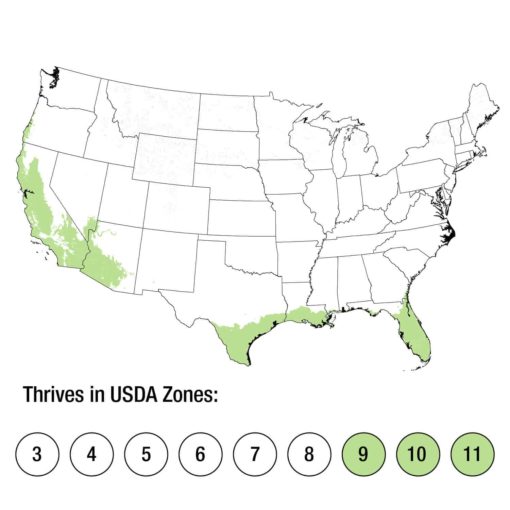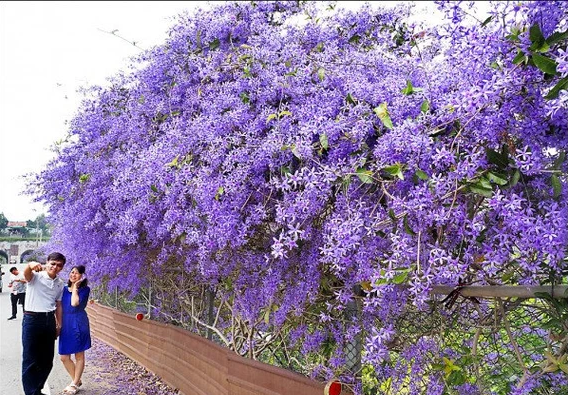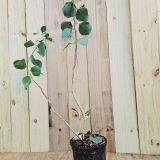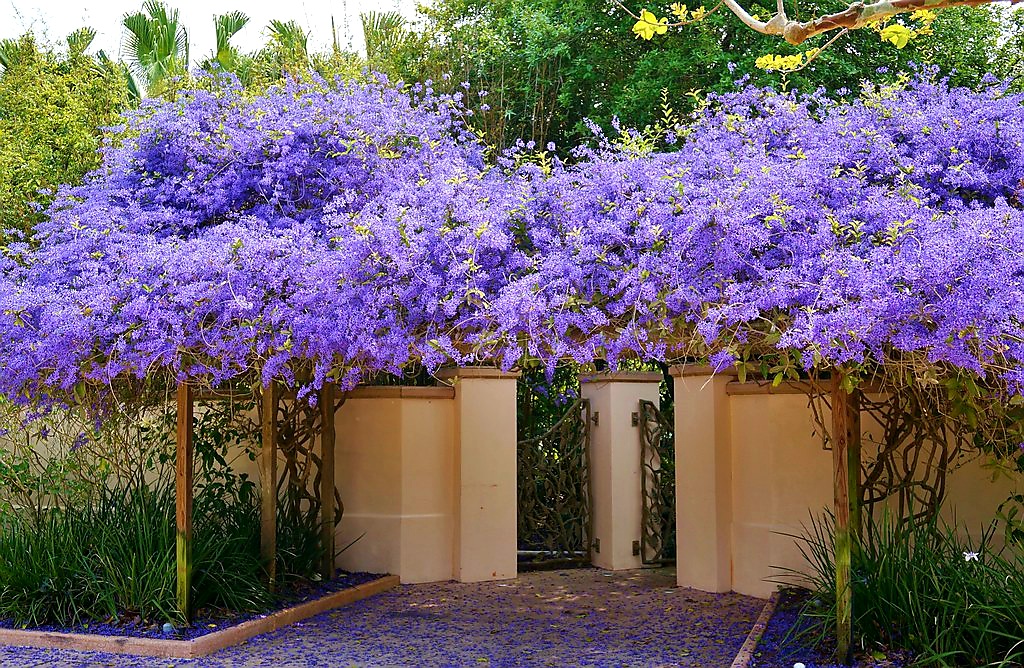- Home
- Flowering plants
- Petrea Volubilis (Purple Wreath, Queen’s Wreath, Sandpaper Vine)
Petrea Volubilis (Purple Wreath, Queen's Wreath, Sandpaper Vine)
Common names: Purple wreath, Queen’s wreath, Sandpaper vine, Sand paper, Nootka Cypress, Bluebird Vine, Florida Wisteria

usda zones
sunlight
Soil & water
fauna
Description of Petrea volubilis
Queen’s wreath (Petrea Volubilis) is a stunning vine if you are on the market to buy tropical flowering plant. It resembles wisteria with its drooping lavender flowers. You may know this vine by one of its other common names: Petrea, purple wreath, or sandpaper vine. The name sandpaper vine refers to the texture of the plant’s leaves which are stiff and feel, as the name suggests, like sandpaper.
This tropical plant has a large native range. It can be found growing south from Southern Mexico through Central America on into northern and western South America down to Paraguay. Queen’s wreath is also found growing in Cuba, Jamaica, Puerto Rico, and Hispaniola.
Queen’s wreath flowers multiple times a year—most profusely between February and June. The flowers are densely packed in a form (called raceme) that, from a distance, resembles a bunch of grapes. The actual flowers are small and light blue or purplish. They will eventually fall, leaving the calyces. A calyx is the base of a flower and is usually green, but queen’s wreath boasts purple calyces as attractive as the true flower petals. The calyces will persist for several weeks, providing your landscape with a little extended color. While the purple-flowered queen’s wreath is more common, there is also a white-flowered cultivar, ‘Albiflora’.
This vine is described as being “variably deciduous,” meaning leaf drop depends on the climate and weather in your specific area. Some plants may drop all leaves during the winter while others only drop some.
While usually found growing as a woody vine, queen’s wreath can be maintained as a shrub or a small, single- or multiple-trunked tree. Left to its own devices, queen’s wreath can reach 40 feet tall, but you can keep it much smaller with occasional pruning.
Care guide for PEtrea volubilis
Petrea volubilis, commonly known as Sandpaper Vine or Queen’s Wreath, is a stunning and resilient climbing vine celebrated for its textured foliage and cascading clusters of lavender to violet-blue flowers. To ensure the optimal health and beauty of this tropical gem, it’s essential to provide thoughtful care that addresses its specific needs. Here’s a comprehensive guide on how to care for Petrea volubilis:
1. Light Requirements: Petrea Volubilis thrives in bright, indirect light, making it well-suited for locations with plenty of sunlight. While it can tolerate partial shade, it typically produces more abundant and vibrant blooms when exposed to full sun. When cultivating Sandpaper Vine indoors, ensure it receives ample natural light, preferably near a south or west-facing window.
2. Soil and Potting Mix: Well-draining soil is crucial for the health of Petrea volubilis. Use a high-quality potting mix enriched with organic matter. A blend formulated for tropical plants or general-purpose potting soil with added perlite or sand to enhance drainage is suitable. When planting or repotting, ensure the container has drainage holes to prevent waterlogging.
3. Watering: Establishing a consistent watering routine is key to keeping Sandpaper Vine healthy. Water the plant when the top inch of soil feels dry to the touch. During the growing season, which typically occurs in warmer months, increase watering frequency. However, be cautious not to overwater, as excessive moisture can lead to root rot. Adjust the watering schedule based on factors like temperature, humidity, and the plant’s growth stage.
4. Humidity: Petrea volubilis hails from tropical regions and appreciates higher humidity levels. While it can adapt to average indoor humidity, providing additional humidity through methods like misting, a humidity tray, or placing a humidifier nearby can promote healthier growth, especially in drier climates.
5. Temperature Tolerance: Maintain temperatures between 65°F to 80°F (18°C to 27°C) for optimal growth. Sandpaper Vine is sensitive to cold temperatures, and exposure to frost can damage the plant. Protect it from drafts and sudden temperature fluctuations.
Petrea volubilis is well-suited for tropical and subtropical regions. It thrives in USDA hardiness zones 9-11, where temperatures remain consistently warm throughout the year. In cooler climates, it can be grown as a container plant and brought indoors during colder seasons.
6. Fertilization: During the growing season (spring and summer), feed Petrea volubilis with a balanced liquid fertilizer every 2-4 weeks. Reduce or eliminate fertilization in the fall and winter when the plant enters a dormant phase. Over-fertilizing can lead to salt buildup, negatively impacting the plant’s health.
7. Pruning and Training: Regular pruning is essential to maintain the desired shape and size of Sandpaper Vine. Trim yellow or damaged leaves and prune to control its growth. Petrea plant responds well to training, and providing support such as stakes, trellises, or arbors allows the plant to climb gracefully. Pruning also helps promote branching and fuller foliage.
8. Support Structure: Given its climbing nature, providing a suitable support structure is crucial. Whether grown indoors or outdoors, offer stakes, trellises, or other climbing aids to guide the vine’s growth. Regularly check and adjust the supports as the plant climbs.
9. Pest Management: Keep an eye out for common pests such as spider mites, mealybugs, and scale insects. Regularly inspect both sides of the leaves and stems. If pests are detected, treat them promptly with insecticidal soap or neem oil.
Propagation Methods
Petrea volubilis’s propagation is best performed through hardwood / semi hardwood cuttings. This method is effective when aiming to replicate specific traits of a mature plant. This process is typically carried out in late summer, allowing the cuttings to establish roots over the fall and winter months.
1. Stem Cuttings:
- Select a healthy hardwood stem with a few leaves.
- Cut the stem just below a node using clean, sharp scissors or pruning shears.
- Place the cutting in water or directly into soil, ensuring the node is submerged or buried.
- Wait for roots to develop before transplanting into a larger container.
Fertilizing queen’s wreath
Fertilize Florida Wisteria during the active growing season, which typically corresponds to spring and summer. These are the months when the plant is putting forth new growth and flowering.
Use a balanced, all-purpose fertilizer with equal or near-equal proportions of nitrogen (N), phosphorus (P), and potassium (K). Alternatively, a fertilizer specifically formulated for flowering plants can be beneficial. Choose a slow-release granular fertilizer for a gradual nutrient release over time.
Petrea Volubilis Care Essentials
This plant thrives in bright, indirect light. Providing the right amount of sunlight is fundamental to its growth, flowering, and overall well-being.










